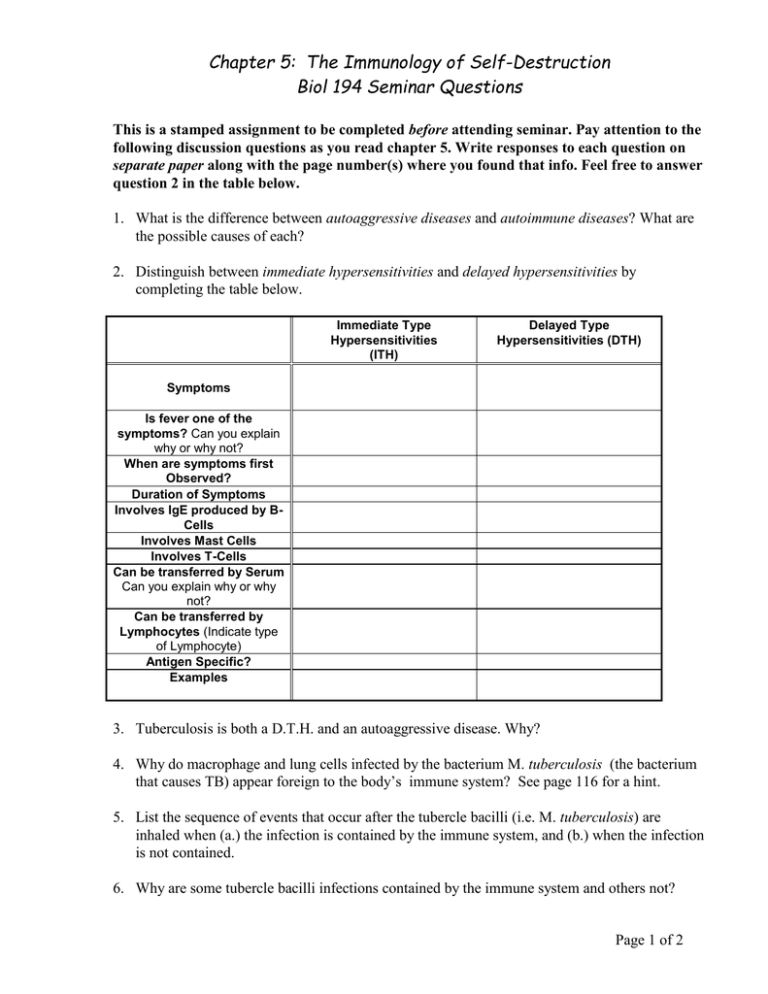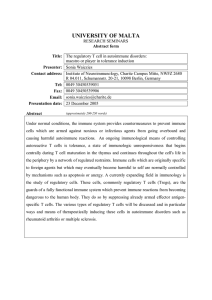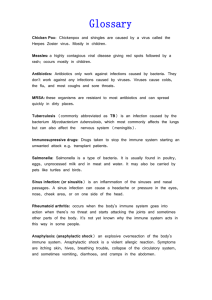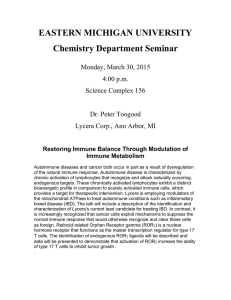Chapter 5: The Immunology of Self-Destruction Biol 194 Seminar Questions
advertisement

Chapter 5: The Immunology of Self-Destruction Biol 194 Seminar Questions This is a stamped assignment to be completed before attending seminar. Pay attention to the following discussion questions as you read chapter 5. Write responses to each question on separate paper along with the page number(s) where you found that info. Feel free to answer question 2 in the table below. 1. What is the difference between autoaggressive diseases and autoimmune diseases? What are the possible causes of each? 2. Distinguish between immediate hypersensitivities and delayed hypersensitivities by completing the table below. Immediate Type Hypersensitivities (ITH) Delayed Type Hypersensitivities (DTH) Symptoms Is fever one of the symptoms? Can you explain why or why not? When are symptoms first Observed? Duration of Symptoms Involves IgE produced by BCells Involves Mast Cells Involves T-Cells Can be transferred by Serum Can you explain why or why not? Can be transferred by Lymphocytes (Indicate type of Lymphocyte) Antigen Specific? Examples 3. Tuberculosis is both a D.T.H. and an autoaggressive disease. Why? 4. Why do macrophage and lung cells infected by the bacterium M. tuberculosis (the bacterium that causes TB) appear foreign to the body’s immune system? See page 116 for a hint. 5. List the sequence of events that occur after the tubercle bacilli (i.e. M. tuberculosis) are inhaled when (a.) the infection is contained by the immune system, and (b.) when the infection is not contained. 6. Why are some tubercle bacilli infections contained by the immune system and others not? Page 1 of 2 7. The infection of liver cells by the hepatitis B virus is by itself not harmful. Why then is the infection so damaging and possibly life threatening? 8. List the sequence of events that occur after the hepatitis B virus infects liver cells when: (a.) the infection is contained by the immune system, and (b.) when the infection is not contained. 9. Freemartins are a type of twin cattle that are genetically dissimilar (i.e. fraternal twins) that share a common blood supply in utero (i.e. during fetal development). A strong (and usually fatal!) immune response occurs between fraternal twins of different blood types that are not freemartins (i.e. do not share the same blood supply before birth). Explain why there is not an immune response when blood is transfused after birth between freemartins having different blood types. When does the mammalian immune system determine what is self and what is not self? 10. What is/are the most likely causes(s) of autoimmune diseases where the immune system attacks apparently healthy tissues in the body that are apparently not infected by an antigen? 11. How are autoimmune diseases treated? Page 2 of 2



